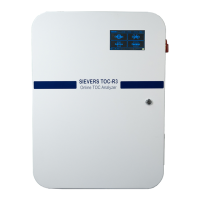DATA INPUTS / OUTPUTS
. . . .. . . ... .... .... .... ..... ..
Sievers TOC-R3 Operation and Maintenance Manual
DLM 95000-01 EN Rev. A 52 © Veolia 2023
Ethernet
The Ethernet Port can be used to output historical data from the Analyzer to a computer,
computer network, or Programmable Logic Controller (PLC). Modbus connectivity is
possible using TCP/IP protocol (LAN). The Ethernet Port also allows for an external
connection to a Windows PC.
Enable this connection to use the “Connectivity” Feature (Remote Control) software, if
desired. For more information, see “Connectivity” on page 157.
For more information on installing and configuring an Ethernet connection, see “Installing
an Ethernet Connection (Optional)” on page 91 and “Configuring the Ethernet Connection
(Optional)” on page 91.
For more information about using the Ethernet connection, see “Using the Ethernet Port”
on page 107.
Digital Input
The four Digital Inputs (Binary) are set by the Analyzer. Each Digital Input channel has a
specific function based on the Analyzer configuration:
• Monitor — Sample Stream Flow Monitoring
• Check — Running a Check Standard Remotely
• Interruption Free — Temporarily Disabling Certain Automated Features
These inputs are especially useful for Two-Stream Analyzers where each stream needs
to be monitored remotely.
For information on how to configure the Digital Inputs, refer to “Digital Input” on page 141
.
Relay
The four Relay (Digital Binary) Outputs are very flexible with settings that are
customizable to trigger based on Conditions, Errors, and Operators. These outputs are
used to alert the User of certain conditions of interest to help remotely monitor the status/
health of the Analyzer.
For information on how to configure the Relay Output(s), refer to “Relay” on page 143
.
Analog Output
The six Analog Outputs transmit analytical data/results to a User’s PLC to remotely
monitor and record data. Each output can be individually programmed/customized and
the output current can be adjusted if necessary.
For information on how to configure the 0/4-20 mA, Analog Outputs, refer to “Analog
Output” on page 139.

